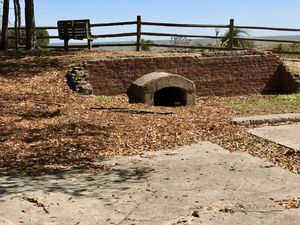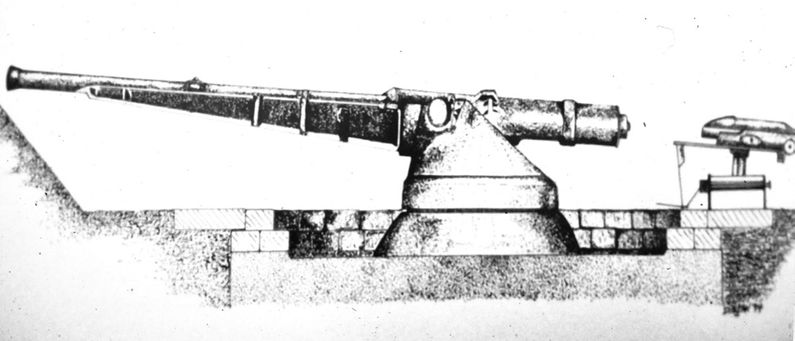Battery Dynamite (2): Difference between revisions
John Stanton (talk | contribs) No edit summary |
John Stanton (talk | contribs) No edit summary |
||
| (2 intermediate revisions by the same user not shown) | |||
| Line 15: | Line 15: | ||
{{HDPortRoyal}} | {{HDPortRoyal}} | ||
Originally built as an experimental concrete coastal gun battery with one 15" M1886 pneumatic dynamite gun mounted on an M1886 Pneumatic carriage. This was a single story battery with the gun located on the same level as the magazine. Shells were moved from the magazine to the gun loading platform by shell cart. No shell or powder hoists were provided. Electrical power was furnished by the emplacement power plant. | Originally built as an experimental concrete coastal gun battery with one 15" M1886 pneumatic dynamite gun mounted on an M1886 Pneumatic carriage. This was a single-story battery with the gun located on the same level as the magazine. Shells were moved from the magazine to the gun loading platform by shell cart. No shell or powder hoists were provided. Electrical power was furnished by the emplacement power plant. | ||
[[File:Battery Dynamite Conduit.jpg|thumb|300px|left|Battery Dynamite Compressed Air Conduit to the Gun Emplacement.]] | [[File:Battery Dynamite Conduit.jpg|thumb|300px|left|Battery Dynamite Compressed Air Conduit to the Gun Emplacement.]] | ||
The gun was powered by compressed air that drove the explosive shells out of the gun tubes. The explosive used in the shells was dynamite. Dynamite shells could not be used in normal guns because the impact of the propellant firing would trigger the dynamite and the shells would explode while still in the gun tube. Compressed air drove the shells out of the gun tube at a lower velocity and with less impact. Because of the lower pressure and no explosive propellant, the gun tubes were very thin and actually required a cantilevered support to keep the gun tube rigid. | The gun was powered by compressed air that drove the explosive shells out of the gun tubes. The explosive used in the shells was dynamite. Dynamite shells could not be used in normal guns because the impact of the propellant firing would trigger the dynamite and the shells would explode while still in the gun tube. Compressed air drove the shells out of the gun tube at a lower velocity and with less impact. Because of the lower pressure and no explosive propellant, the gun tubes were very thin and actually required a cantilevered support to keep the gun tube rigid. | ||
Since the gun was experimental, the contractor provided the guns, carriages and the emplacements as well as the considerable amount of machinery necessary to produce the highly compressed air. Two steam engines powered an electrical generator and the two air compressors that furnished compressed air at 2,000 psi to the gun emplacement. | Since the gun was experimental, the contractor provided the guns, carriages, and the emplacements as well as the considerable amount of machinery necessary to produce the highly compressed air. Two steam engines powered an electrical generator and the two air compressors that furnished compressed air at 2,000 psi to the gun emplacement. | ||
{{Clr}} | {{Clr}} | ||
The gun was successfully test fired on 8 Dec 1901 and reportedly fired more than 100 projectiles before it was deactivated. The Battery was deactivated in 1902 and the guns and carriages were removed and later salvaged in 1917. | The gun was successfully test-fired on 8 Dec 1901 and reportedly fired more than 100 projectiles before it was deactivated. The Battery was deactivated in 1902 and the guns and carriages were removed and later salvaged in 1917. | ||
{{Clr}} | {{Clr}} | ||
| Line 29: | Line 29: | ||
== Current Status == | == Current Status == | ||
The battery is in ruins, no period guns or mounts in place. Two walls of the power plant are partially upright, only foundations of the steam plant remain, and the gun emplacement is all broken up but recognizable. Markers and signage are in place to explain the site. | The battery is in ruins, with no period guns or mounts in place. Two walls of the power plant are partially upright, only the foundations of the steam plant remain, and the gun emplacement is all broken up but recognizable. Markers and signage are in place to explain the site. | ||
Public access to the site is limited because the site is within the confines of the gated Palmetto Dunes Resort. The best option for viewing is by a fort tour conducted by the Coastal Discovery Museum at Hilton Head. As of 2018 the Museum conducts this guided tour on Wednesdays at 10 am and it visits [[Fort Welles]], the Steam Gun (Dynamite Battery), and [[Fort Sherman (4)]], the tour guide was very knowledgeable. You can reserve this tour online, a fee applies. | Public access to the site is limited because the site is within the confines of the gated Palmetto Dunes Resort. The best option for viewing is by a fort tour conducted by the Coastal Discovery Museum at Hilton Head. As of 2018 the Museum conducts this guided tour on Wednesdays at 10 am and it visits [[Fort Welles]], the Steam Gun (Dynamite Battery), and [[Fort Sherman (4)]], the tour guide was very knowledgeable. You can reserve this tour online, a fee applies. | ||
| Line 35: | Line 35: | ||
{| | {| | ||
| | | | ||
<googlemap version="0.9" lat="32.2355" lon="-80.6776" zoom="19" width="500" scale="yes" overview="yes" controls="large" icons="http://www.fortwiki.com/mapicons/icon{label}.png"> | <googlemap version="0.9" lat="32.2355" lon="-80.6776" zoom="19" width="-500" height="-500" scale="yes" overview="yes" controls="large" icons="http://www.fortwiki.com/mapicons/icon{label}.png"> | ||
(B) 32.23544, -80.67743, Battery Dynamite (2) | (B) 32.23544, -80.67743, Battery Dynamite (2) | ||
(1897-1902) | (1897-1902) | ||
| Line 47: | Line 47: | ||
|} | |} | ||
See Also: | '''See Also:''' | ||
* [[Fort Welles]] | * [[Fort Welles]] | ||
* [[Battery Dynamite (1)]] | * [[Battery Dynamite (1)]] | ||
| Line 58: | Line 58: | ||
* [http://query.nytimes.com/mem/archive-free/pdf?res=FB0E13F7355D12738DDDA00894DA415B818CF1D3 New York Times 9 Dec 1901] | * [http://query.nytimes.com/mem/archive-free/pdf?res=FB0E13F7355D12738DDDA00894DA415B818CF1D3 New York Times 9 Dec 1901] | ||
* [http://query.nytimes.com/mem/archive-free/pdf?res=F40D10F93B591B728DDDAF0894DC405B828CF1D3 New York Times 6 Apr 1902] | * [http://query.nytimes.com/mem/archive-free/pdf?res=F40D10F93B591B728DDDAF0894DC405B828CF1D3 New York Times 6 Apr 1902] | ||
{{Visited|7 Mar 2018}} | {{Visited|7 Mar 2018}} | ||
Latest revision as of 17:48, 28 August 2021
|
Endicott Period (1890-1910)Part of the Harbor Defense of Port Royal Sound. Originally built as an experimental concrete coastal gun battery with one 15" M1886 pneumatic dynamite gun mounted on an M1886 Pneumatic carriage. This was a single-story battery with the gun located on the same level as the magazine. Shells were moved from the magazine to the gun loading platform by shell cart. No shell or powder hoists were provided. Electrical power was furnished by the emplacement power plant.  The gun was powered by compressed air that drove the explosive shells out of the gun tubes. The explosive used in the shells was dynamite. Dynamite shells could not be used in normal guns because the impact of the propellant firing would trigger the dynamite and the shells would explode while still in the gun tube. Compressed air drove the shells out of the gun tube at a lower velocity and with less impact. Because of the lower pressure and no explosive propellant, the gun tubes were very thin and actually required a cantilevered support to keep the gun tube rigid. Since the gun was experimental, the contractor provided the guns, carriages, and the emplacements as well as the considerable amount of machinery necessary to produce the highly compressed air. Two steam engines powered an electrical generator and the two air compressors that furnished compressed air at 2,000 psi to the gun emplacement.

Current StatusThe battery is in ruins, with no period guns or mounts in place. Two walls of the power plant are partially upright, only the foundations of the steam plant remain, and the gun emplacement is all broken up but recognizable. Markers and signage are in place to explain the site. Public access to the site is limited because the site is within the confines of the gated Palmetto Dunes Resort. The best option for viewing is by a fort tour conducted by the Coastal Discovery Museum at Hilton Head. As of 2018 the Museum conducts this guided tour on Wednesdays at 10 am and it visits Fort Welles, the Steam Gun (Dynamite Battery), and Fort Sherman (4), the tour guide was very knowledgeable. You can reserve this tour online, a fee applies.
See Also: Sources: Links: Visited: 7 Mar 2018
| ||||||||||||||||||||||||||||||||


